RDP 9609: Australian Financial Market Volatility: An Exploration of Cross-Country and Cross-Market Linkages 4. Australia and the US: Cross-Market Linkages
November 1996
- Download the Paper 777KB
This section extends the empirical examination undertaken in previous parts of the paper by exploring cross-market as well as cross-country linkages pertaining to Australia's key financial markets.
Given the predominant influence of the US documented in earlier sections, the cross-country link is restricted to the Australia-US pairing. This is supplemented by an explicit consideration of intra-Australian financial market linkages. To illustrate, for the Australian bond market, we examine how changes in Australian bond yields are influenced not only by corresponding movements in US bond yields, but also by changes in US share prices, changes in Australian share prices, and movements in the Australia's TWI exchange rate. A similar examination is undertaken for changes in Australian share prices.
Figure 17 summarises the results from estimations attempting to evaluate the relative importance of cross-market and cross-country influences on daily changes in Australian bond yields. Figure 17 is derived from rolling regressions of equations (4a.1) to (4a.5) detailed in Box 4a below. Once again, these rolling regressions employ a 120-day (6-month) moving window of daily observations over the period February 1987 to February 1996.
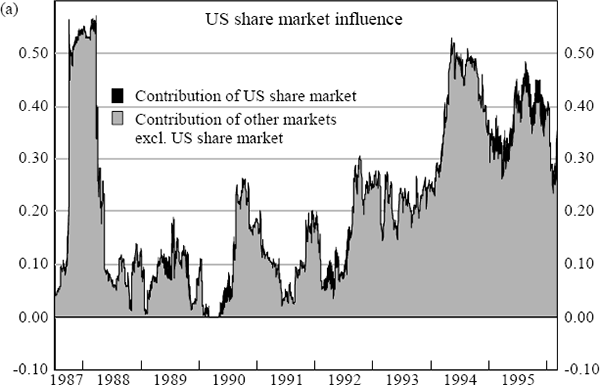
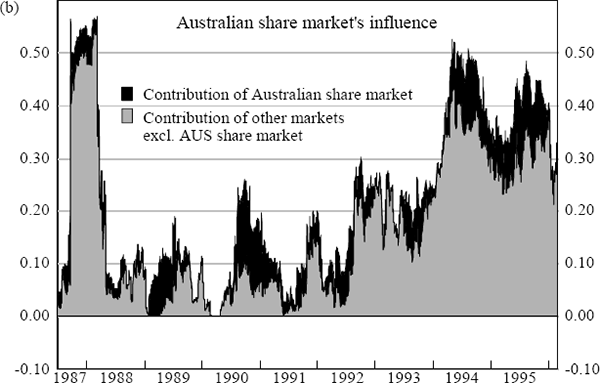
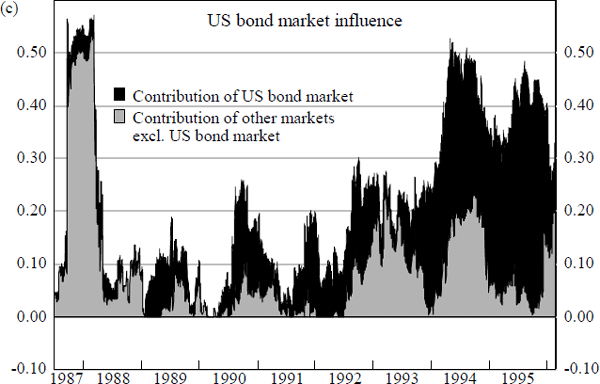
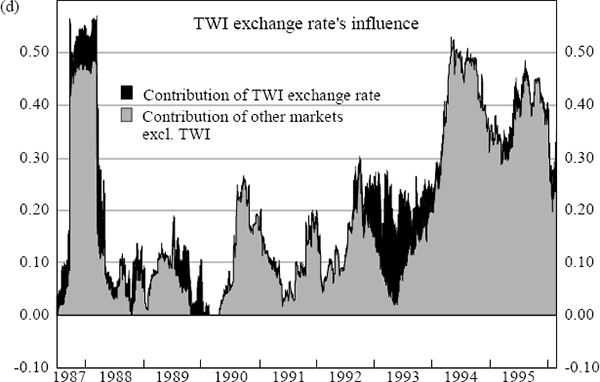
In this set of estimations the influence of a particular market on Australian bond yield
movements is measured by the reduction in equation (4a.1)'s explanatory power when the
regressor representing that market is excluded from the equation specification. To illustrate,
equation (4a.3) includes all of the regressors in equation (4a.1)'s specification except
that which represents the daily change in US share prices. Accordingly, the US share market's
influence or spillover on the Australian bond market is given by the difference in the adjusted
coefficients of determination of the unrestricted and restricted regression equations, ie  .[20]
.[20]
Box 4a: Australian Bond Market
Daily basis point changes
where:  is the daily basis point change in country m's long
bond yield,
is the daily basis point change in country m's long
bond yield,  is the daily percentage change in country m's
share price index, and ext is the daily percentage change in Australia's
TWI exchange rate.
is the daily percentage change in country m's
share price index, and ext is the daily percentage change in Australia's
TWI exchange rate.
Figure 17 confirms that overnight (Australian time) changes in US bond yields are the most important influence on Australian bond-yield movements. Its exclusion as a regressor from equation (4a.1) leads to the largest reduction in explanatory power.
The next most important influence, out of the four markets under consideration, appears to be daily movements in Australian share prices. Its incremental contribution to explanatory power is episodic, being prominent only during periods of financial market turbulence such as the 1987 stock-market crash, the 1989 mini-collapse, the period during the Iraqi invasion of Kuwait, and the 1994 bond market ‘sell-off’.
Daily movements in the TWI nominal exchange rate is next. Only in two periods, (i) the 1987 stock-market crash and (ii) throughout most of 1993, do daily percentage changes in the nominal TWI contribute significantly to explanatory power. Daily percentage changes in the US share price index appear to have the least influence on daily changes in Australian bond yields. As can be clearly seen from Figure 17 its exclusion from the regression equation is inconsequential with respect to reductions in explanatory power.
To summarise, for daily yield changes in the Australian bond market, we have the following rankings in descending order of importance: (i) US bond market, (ii) Australian share market, (iii) TWI exchange rate, and (iv) US share market.
The results from a similar examination undertaken for daily changes in the Australian share market are depicted in Figure 18, with the equations underlying the rolling regression estimates outlined in Box 4b. [21]
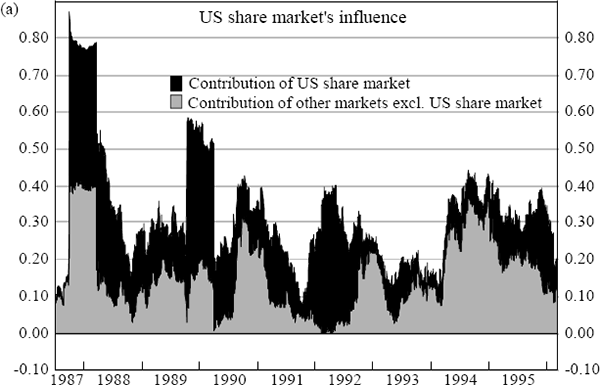
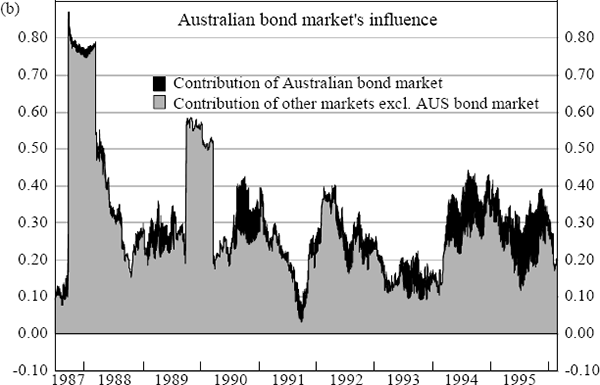
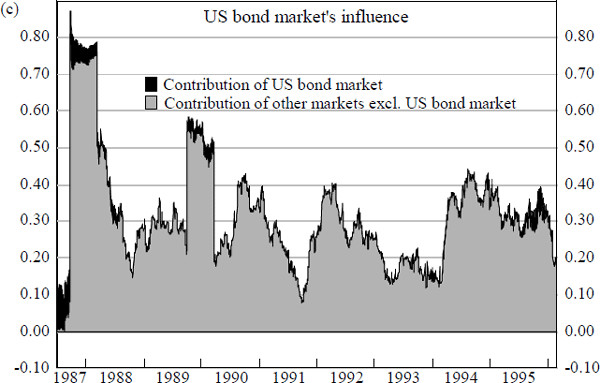
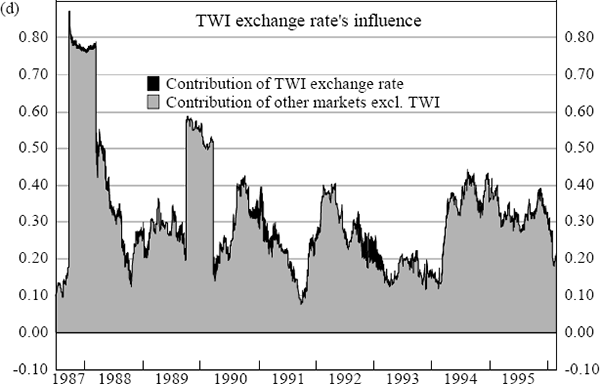
Out of the four markets under consideration, Figure 18 clearly identifies changes in US share prices as the most important influence on daily movements in Australian share prices. As with the Australian bond market, the counterpart US market has the predominant influence. Contemporaneous daily changes in Australian bond yields provide the next largest influence, as measured by its contribution to explanatory power. This is followed by changes in US bond yields, and contemporaneous percentage changes in the TWI exchange rate. The marginal contributions to explanatory power of these last two variables are equally small.
Box 4b: Australian Share Market (Daily percentage changes)
where:  is the daily basis point change in country m's long
bond yield,
is the daily basis point change in country m's long
bond yield,  is the daily percentage change in country m's
share price index, and ext is the daily percentage change in Australia's
TWI exchange rate.
is the daily percentage change in country m's
share price index, and ext is the daily percentage change in Australia's
TWI exchange rate.
The results from Figures 17 and 18 collectively tend to suggest that cross-country spillovers or influences within the same market (eg US share market – Australian share market and US bond market – Australian bond market) are far more pronounced than cross-market/instrument linkages within the same country (eg Australian bond market – Australian share market or Australian bond market – Australian foreign exchange market).
Footnotes
Thus in Figure 17 Chart (a), we have the following definitions: Contribution of US
Share Market  and Contribution of Other Markets
Excluding US Share Market ≡
and Contribution of Other Markets
Excluding US Share Market ≡  . Similarly in Chart
(b) we have Contribution of Australian Share Market ≡
. Similarly in Chart
(b) we have Contribution of Australian Share Market ≡  and Contribution of Other Markets Excluding Australian Share Market ≡
and Contribution of Other Markets Excluding Australian Share Market ≡
 ;
in Chart (c) we have Contribution of US Bond Market
;
in Chart (c) we have Contribution of US Bond Market  and Contribution of Other Markets Excluding US Bond Market ≡
and Contribution of Other Markets Excluding US Bond Market ≡  ;
and in Chart (d) we have Contribution of TWI Exchange Rate
;
and in Chart (d) we have Contribution of TWI Exchange Rate  and Contribution of Other Markets Excluding TWI ≡
and Contribution of Other Markets Excluding TWI ≡  .
[20]
.
[20]
Thus in Figure 18 Chart (a), we have the following definitions: Contribution of US
Share Market  and Contribution of Other Markets
Excluding US Share Market ≡
and Contribution of Other Markets
Excluding US Share Market ≡  . Similarly in Chart
(b) we have Contribution of Australian Bond Market ≡
. Similarly in Chart
(b) we have Contribution of Australian Bond Market ≡  and Contribution of Other Markets Excluding Australian Bond Market ≡
and Contribution of Other Markets Excluding Australian Bond Market ≡  ;
in Chart (c) we have Contribution of US Bond Market
;
in Chart (c) we have Contribution of US Bond Market  and Contribution of Other Markets Excluding US Bond Market ≡
and Contribution of Other Markets Excluding US Bond Market ≡  ;
and in Chart (d) we have Contribution of TWI Exchange Rate
;
and in Chart (d) we have Contribution of TWI Exchange Rate  and Contribution of Other Markets Excluding TWI ≡
and Contribution of Other Markets Excluding TWI ≡  .
[21]
.
[21]









